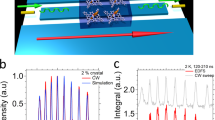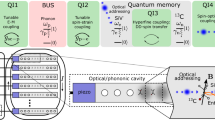Abstract
The transfer of information between different physical forms—for example processing entities and memory—is a central theme in communication and computation. This is crucial in quantum computation1, where great effort2 must be taken to protect the integrity of a fragile quantum bit (qubit). However, transfer of quantum information is particularly challenging, as the process must remain coherent at all times to preserve the quantum nature of the information3. Here we demonstrate the coherent transfer of a superposition state in an electron-spin ‘processing’ qubit to a nuclear-spin ‘memory’ qubit, using a combination of microwave and radio-frequency pulses applied to 31P donors in an isotopically pure 28Si crystal4,5. The state is left in the nuclear spin on a timescale that is long compared with the electron decoherence time, and is then coherently transferred back to the electron spin, thus demonstrating the 31P nuclear spin as a solid-state quantum memory. The overall store–readout fidelity is about 90 per cent, with the loss attributed to imperfect rotations, and can be improved through the use of composite pulses6. The coherence lifetime of the quantum memory element at 5.5 K exceeds 1 s.
This is a preview of subscription content, access via your institution
Access options
Subscribe to this journal
Receive 51 print issues and online access
$199.00 per year
only $3.90 per issue
Buy this article
- Purchase on Springer Link
- Instant access to full article PDF
Prices may be subject to local taxes which are calculated during checkout




Similar content being viewed by others
References
Deutsch, D. Quantum theory, the Church-Turing principle and the universal quantum computer. Phil. Trans. R. Soc. Lond. A 400, 97–117 (1985)
Steane, A. M. Efficient fault-tolerant quantum computing. Nature 399, 124–126 (1999)
Julsgaard, B., Sherson, J., Cirac, J. I., Fiuráek, J. & Polzik, E. S. Experimental demonstration of quantum memory for light. Nature 432, 482–486 (2004)
Kane, B. E. A silicon-based nuclear spin quantum computer. Nature 393, 133–137 (1998)
Tyryshkin, A. M. et al. Coherence of spin qubits in silicon. J. Phys. Condens. Matter 18, S783–S794 (2006)
Morton, J. J. L. et al. High fidelity single qubit operations using pulsed electron paramagnetic resonance. Phys. Rev. Lett. 95, 200501 (2005)
Wootters, W. K. & Zurek, W. H. A single quantum cannot be cloned. Nature 299, 802–803 (1982)
Kielpinski, D. et al. A decoherence-free quantum memory using trapped ions. Science 291, 1013–1015 (2001)
Dutt, M. V. G. et al. Quantum register based on individual electronic and nuclear spin qubits in diamond. Science 316, 1312–1316 (2007)
Dobrovitski, V. V., Taylor, J. M. & Lukin, M. D. Long-lived memory for electronic spin in a quantum dot: Numerical analysis. Phys. Rev. B 73, 245318 (2006)
Tyryshkin, A. M., Lyon, S. A., Astashkin, A. V. & Raitsimring, A. M. Electron spin relaxation times of phosphorus donors in silicon. Phys. Rev. B 68, 193207 (2003)
Tyryshkin, A. M., Morton, J. J. L., Ardavan, A. & Lyon, S. A. Davies electron-nuclear double resonance revisited: Enhanced sensitivity and nuclear spin relaxation. J. Chem. Phys. 124, 234508 (2006)
Stegner, A. R. et al. Electrical detection of coherent 31P spin quantum states. Nature Phys. 2, 835–838 (2006)
McCamey, D. R. et al. Electrically detected magnetic resonance in ion-implanted Si:P nanostructures. Appl. Phys. Lett. 89, 182115 (2006)
Lo, C. C. et al. Spin-dependent scattering off neutral antimony donors in 28Si field-effect transistors. Appl. Phys. Lett. 91, 242106 (2007); Appl. Phys. Lett. 92, 109908 (2008)
Hirsch, M. J. & Holcomb, D. F. NMR study of Si:As and Si:P near the metal-insulator transition. Phys. Rev. B 33, 2520–2529 (1986)
Feher, G. Electron spin resonance experiments on donors in silicon I: Electronic structure of donors by the electron nuclear double resonance technique. Phys. Rev. 114, 1219–1244 (1959)
Mehring, M., Mende, J. & Scherer, W. Entanglement between an electron and a nuclear spin 1/2. Phys. Rev. Lett. 90, 153001 (2003)
Viola, L. & Lloyd, S. Dynamical suppression of decoherence in two-state quantum systems. Phys. Rev. A 58, 2733–2744 (1998)
Morton, J. J. L. et al. Bang-bang control of fullerene qubits using ultra-fast phase gates. Nature Phys. 2, 40–43 (2006)
Höfer, P., Grupp, A. & Mehring, M. High-resolution time-domain electron-nuclear-sublevel spectroscopy by pulsed coherence transfer. Phys. Rev. A 33, 3519–3522 (1986)
Morton, J. J. L. et al. The N@C60 nuclear spin qubit: Bang-bang decoupling and ultrafast phase gates, Phys. Status Solidi B 243, 3028–3031 (2006)
Morton, J. J. L. et al. Measuring errors in single-qubit rotations by pulsed electron paramagnetic resonance. Phys. Rev. A 71, 012332 (2005)
Cummins, H. K., Llewellyn, G. & Jones, J. A. Tackling systematic errors in quantum logic gates with composite rotations. Phys. Rev. A 67, 042308 (2003)
Taylor, J. M. et al. Fault-tolerant architecture for quantum computation using electrically controlled semiconductor spins. Nature Phys. 1, 177–183 (2005)
Thaker, D. D., Metodi, T. S., Cross, A. W., Chuang, I. L. & Chong, F. T. in ISCA ’06 378–390 (Proc. 33rd Internat. Symp. Computer Architecture, IEEE, 2006)
Rabl, P. et al. Hybrid quantum processors: Molecular ensembles as quantum memory for solid state circuits. Phys. Rev. Lett. 97, 033003 (2006)
Nowack, K. C., Koppens, F. H. L., Nazarov, Y. V. & Vandersypen, L. M. K. Coherent control of a single electron spin with electric fields. Science 318, 1430–1433 (2007)
Sarovar, M., Young, K. C., Schenkel, T. & Whaley, K. B. Quantum non-demolition measurements of single spins in semiconductors. Preprint at 〈http://arxiv.org/abs/0711.2343v1〉 (2007)
Ager, J. W. et al. High-purity, isotopically enriched bulk silicon. J. Electrochem. Soc. 152, G448–G451 (2005)
Acknowledgements
We thank G. A. D. Briggs for comments and support and R. Weber, P. Höfer and Bruker Biospin for support with instrumentation. We thank P. Weaver of Advanced Silicon Materials, Inc. for zone-refining and H. Riemann of the Institut für Kristallzüchtung for float-zone processing of the 28Si crystals used in this work. This research is supported by the National Security Agency (MOD 713106A) and the EPSRC through the Quantum Information Processing Interdisciplinary Research Collaboration (GR/S82176/01) and CAESR (EP/D048559/1). J.J.L.M. is supported by St John’s College, Oxford. A.A. and B.W.L. are supported by the Royal Society. Work at Princeton received support from the US National Science Foundation through the Princeton MRSEC (DMR-0213706). Work at Lawrence Berkeley National Laboratory was supported by the Director, Office of Science, Office of Basic Energy Sciences, Materials Sciences and Engineering Division of the US Department of Energy (DE-AC02-05CH11231).
Author information
Authors and Affiliations
Corresponding author
Supplementary information
Supplementary Information
This file contains (A) calculations which confirm the effect of radiofrequency and microwave phases stated in the main text; (B) electron and nuclear relaxation model; and (C) density matrix tomography for all initial states (incorporating Supplementary Figures 1-3). (PDF 863 kb)
Rights and permissions
About this article
Cite this article
Morton, J., Tyryshkin, A., Brown, R. et al. Solid-state quantum memory using the 31P nuclear spin. Nature 455, 1085–1088 (2008). https://doi.org/10.1038/nature07295
Received:
Accepted:
Issue Date:
DOI: https://doi.org/10.1038/nature07295
This article is cited by
-
Tuning Effective Relaxation Time in CPMG Sequence by Varying the Rotation Angle of the Refocusing Pulses
Applied Magnetic Resonance (2023)
-
Towards entanglement distillation between atomic ensembles using high-fidelity spin operations
Communications Physics (2022)
-
Modeling of Thermogasdynamics and Thermal Processes of Volatile Halides of Elements of III, IV and VI Groups in Thermal Plasma of RF-IC Discharge at Atmospheric Pressure
Plasma Chemistry and Plasma Processing (2022)
-
Quantum sensing of a coherent single spin excitation in a nuclear ensemble
Nature Physics (2021)
-
Quantum guidelines for solid-state spin defects
Nature Reviews Materials (2021)
Comments
By submitting a comment you agree to abide by our Terms and Community Guidelines. If you find something abusive or that does not comply with our terms or guidelines please flag it as inappropriate.



